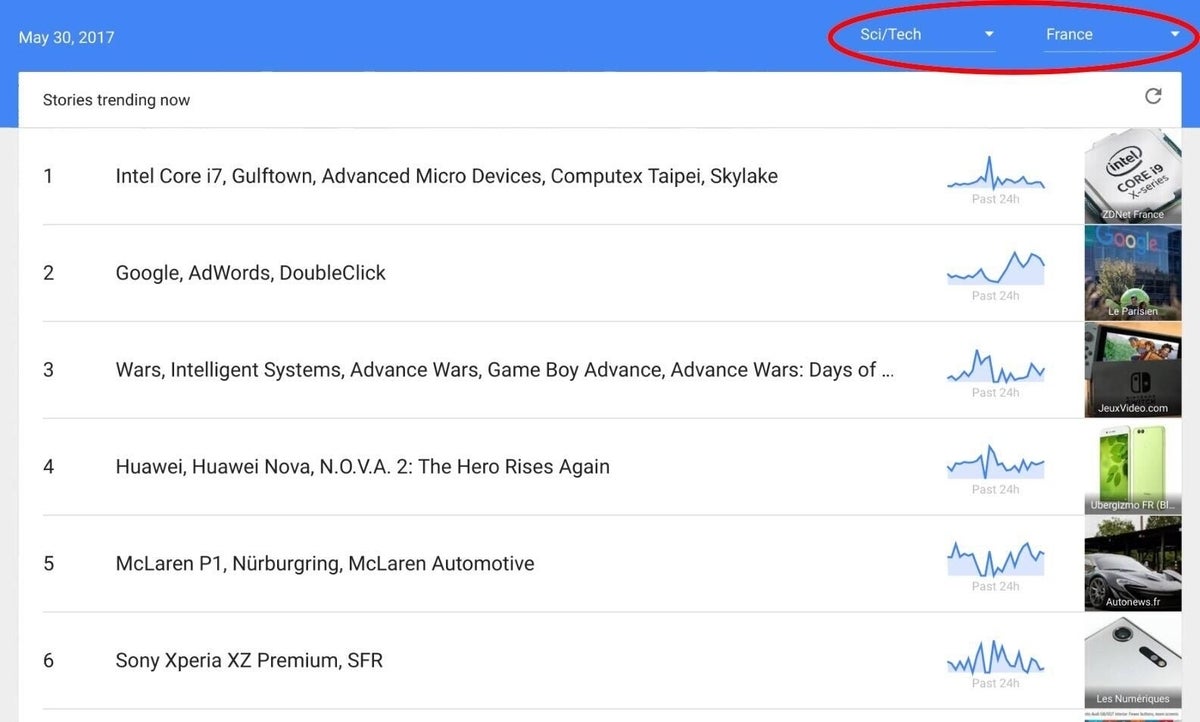
Google Trends can help you measure brand popularity, prepare for a business trip, identify new markets, track tech trends, and communicate more clearly.
Google Trends shows the relative popularity of a keyword over time. For example, Trends shows that the term “Chromebook” first appears in late 2010, and increases in popularity as more people search for the term. By default, Trends shows the relative popularity of a term worldwide over the past five years, but you can adjust the time period and/or select a specific country.

Trends also can disambiguate terms. Type the keyword Go, and you’ll see options listed below that distinguish between Go, the game; and Go, the programming language. Always look at the options, as the difference can be dramatic: The popularity of Swift, the programming language, returns significantly different results than (Taylor) Swift, the musician. The related topics and queries that Trends displays may help you refine your keywords.

While Trends is useful for marketing, tech professionals can use the data for several other purposes.
1. Measure brand popularity
Try Trends searches for your company and your products and services, as well as those of your competitors and vendors. You can add up to five terms in Google Trends to compare their relative search popularity. For example, I entered the names of five computer hardware manufacturers. Trends shows the strength of the Apple brand: More people search for Apple than the competing brands.

Before you buy from an unfamiliar vendor, look up the vendor’s company and product brands on Trends. You may need external information to fully understand or explain Trends results. Note that searches for Apple increase around September each year, which correlates with the release date of a new iPhone. Searches for United Airlines spiked in early 2017, but anyone who followed the news from that time knows it wasn’t a good time for the company. If you see a spike in searches, look for news items around those dates.
2. Prepare for a business trip
Before you travel internationally, explore the top trends at your destination. Heading to Paris? Set the country to France to see recent search trends in that country. In the tech industry? Narrow the focus further by changing the category to Sci/Tech for trending searches in the sector. You’ll at least be aware of some of the top topics that people in the country currently care about. (This is also a great way to get a slightly different perspective on news and issues, even if you don’t travel!)

3. Identify new markets
Relative popularity of search trends may also help you prioritize promotions in new markets. For example, if you sell cloud backup and want to promote your service internationally, Trends can help inform your decision. After the US, cloud backup (see Trends info: https://g.co/trends/ejzhU) ranks second in the UK, while Canada is down the list in eighth, with France much further down the list (17th). The UK would be the obvious expansion target. Note these rankings indicate the relative percentage of searches within each respective country. Obviously, Trends data shouldn’t be the only data you use to make this decision, but it can help inform discussions and decisions.
4. Track tech trends
Google Trends data can show popular interest in technologies over time, too. Enter tech terms, then expand the time horizon to as long a term as possible to see how popularity changes. The trends for Bitcoin and podcast (see Trends info: https://g.co/trends/Fc1HN) both show an initial peak then a decline, followed by a resurgence. Contrast that with VOIP (see Trends info: https://g.co/trends/E6HT5), which hit peak popularity somewhere in 2005 to 2006, and has declined ever since. One explanation for this may be that as technologies become more widely known and understood, fewer people search for the topic.
Subscribe to Trends terms to receive updates on terms you choose. Go to https://trends.google.com/trends/subscriptions, enter your term, then choose Add subscription, then enter the keywords you want to track. It’s sort of like Google Alerts, but for search popularity. Google Alerts notifies you when Google indexes a page with the term you choose, while a Google Trends subscription helps you track relative popularity of a topic over time.

5. Communicate more clearly
Finally, Trends can help you choose between words. For instance, the terms livestream and webcast both convey similar meaning, but these days people search for livestream more often. Until 2008, webcast was the more common term. Trends can help you select a term familiar to more people.

I applied this technique to the first sentence of this post. It turns out that technology trends is more popular than tech trends, and business travel is searched for more often than business trip. A sentence filled with more popular terms would read as follows: Google Trends can help you measure brand strength, prepare for business travel, identify a new market, track technology trends, and communicate better.
How do you use Google Trends for work? Have you used Trend data to choose more search-friendly terms? Let us know in the comments or on Twitter!